Orientation Discrimination: Lesson 1
This step-by-step tutorial teaches you how to build and run your first experimental design. More specifically, you will learn how to:
1) create the hierarchical structure of a basic experiment,
2) customize the events,
3) use variables to connect procedural and stimulus events,
4) run the experiment and visualize the results!
BASIC TASK
The aim of this experiment is to measure orientation discrimination thresholds with Gabor stimuli using a staircase method and a 2AFC procedure. To learn more about Orientation Discrimination, see:
Step 1: Opening the "Designer" Panel
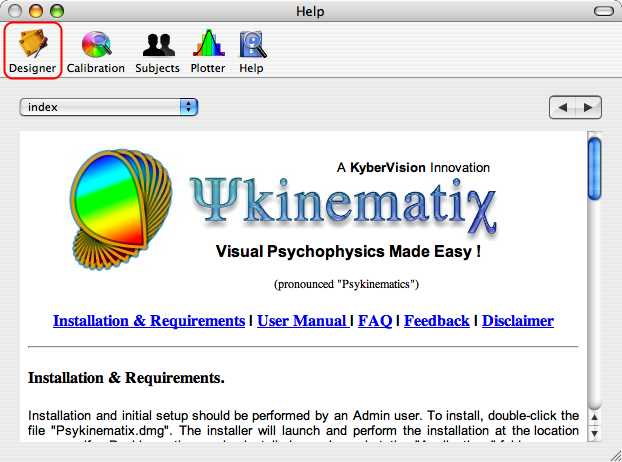
Launch Psykinematix, and select the Designer panel by clicking on its icon in the toolbar.
Step 2: Adding an Experiment Event
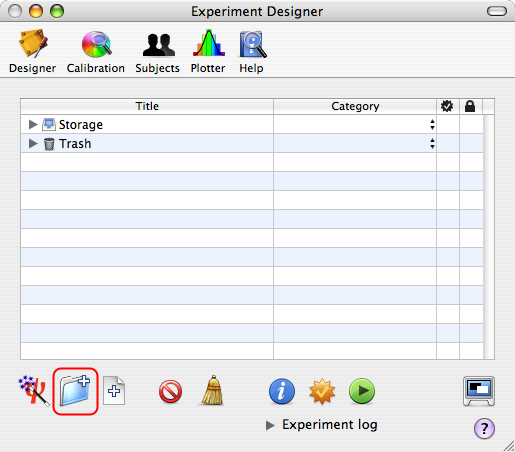
The Experiment Designer panel presents a hierarchical view of the experiments. Before going further, make sure to deselect any event by clicking on an empty row or Apple-clicking on the selected event to deselect it.
Now, create a new group event by clicking on the folder icon with the '+' symbol in the bottom toolbar.
Tip: A group event embeds one or several events.

The new event appears at the top in the table with a default title (New Events). Change its title to Orientation Discrimination to reflect the experiment purpose (double-click on the title to edit it).
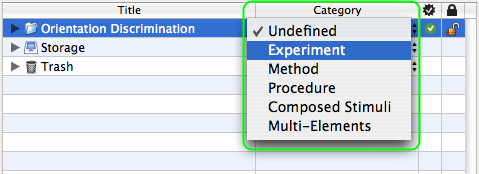
Each event is characterized by a category that defines its function inside your experimental design. To change the default category (Undefined), use the pop-up menu to select the Experiment entry. Note how the small icon in front of the event changed from a small folder to a small red psi icon specific to the Experiment event.
Tips:
Each category of events has its own small icon to depict its function.
The Undefined category can still be used to group several experiments under one roof (eg: all experiments related to the same study).
Step 3: Adding a Staircase Method
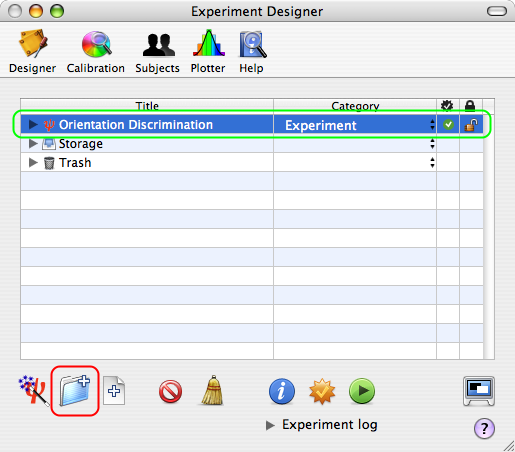
Select the Experiment event you just created (Orientation Discrimination), and add a new group event by clicking on the '+' folder icon again.

A new Undefined event embedded in the Experiment event is automatically revealed with its title ready to be renamed.
Tip: Click on the small arrow in front of a group event to expand or collapse the first level of its hierarchical structure (option-click to reveal the whole hierarchy). The first level can be also revealed or hidden by selecting the event and pressing the space bar.

Change the title and category of the new event to Staircase and Method as illustrated.
Step 4: Adding a 2AFC Procedure

Similarly to the previous step, select the Method event, add a new group event, and change its title and category to 2AFC and Procedure.
Step 5: Adding a Gabor Stimulus
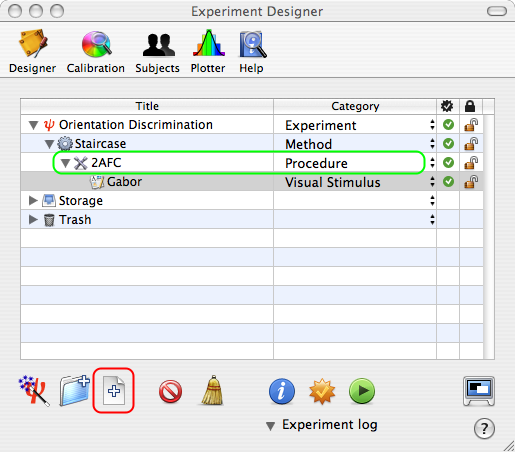
Now, select the Procedure event, and add a new leaf event by clicking on the file icon with the '+' symbol in the bottom toolbar. Change its title and category to Gabor and Visual Stimulus as illustrated.
Tip: As atomic events, leaf events do not embed other events hence the absence of the small arrow in front of their descriptive mini-icon.
We have completed the basic hierarchical structure of the experiment, so let's move on to the customization of each event.
Step 6: Customizing the Method
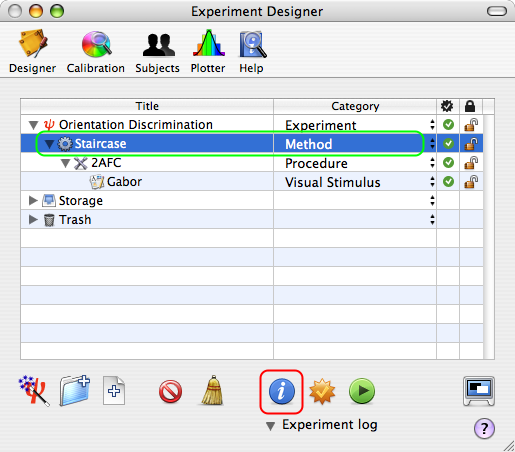
Click on the Staircase event to select it, and click on the Inspector button (or press the Apple-i keystroke) to inspect the properties of the Method.
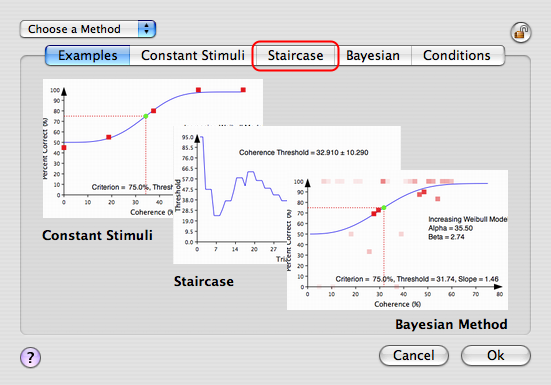
A properties page for the Method event appears with the Examples tab selected by default. Control-click on the Staircase tab to select the Staircase Method and view/edit its properties.
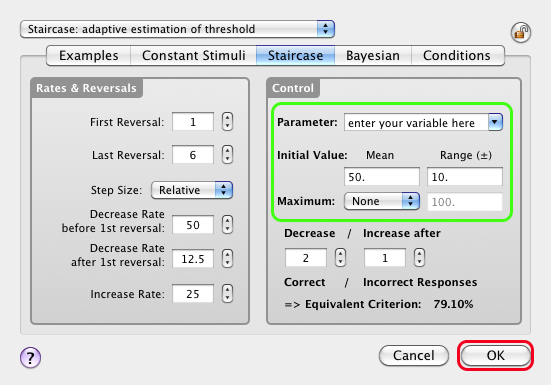
The default settings are suitable for a standard staircase method but should be customized to better fit your experimental requirements. The mandatory changes are those associated with the stimulus parameter that drives the threshold estimation during the experiment, as illustrated below with the Gabor orientation which is the dependent variable of this experimental design.
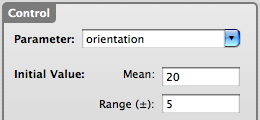
The name of the stimulus parameter and its initial value (in the range specified by a uniform distribution, mean ± deviation) need to be set appropriately. Change these values to match those of the figure: the parameter is named "orientation" and its initial value is set in the range 20 ± 5 (degrees).
Click on the OK button on the properties page to validate these changes and return to the Designer panel.
Step 7: Customizing the Procedure
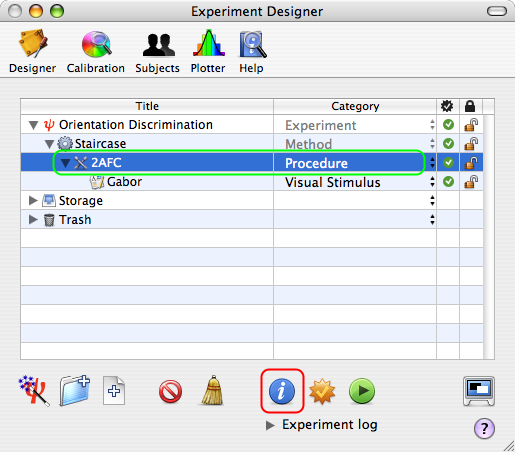
Once you have returned to the Designer panel, select the 2AFC Procedure event, and click on the Inspector button to inspect its properties.
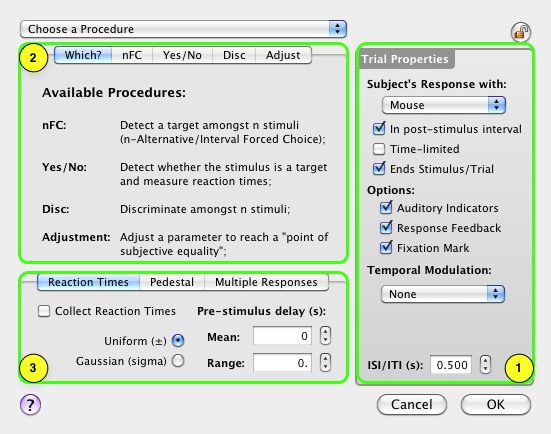
The properties page for the Procedure event consists of three sections:
1) A right side common to all procedures that specifies the properties to be applied to each trial
2) A top-left section that specifies the type of procedure (Which? tab selected by default) and its properties
3) A bottom-left section that provides more customization for some of the procedures (reaction times and pedestal)
Let's customize each of these sections:

1) First, in Trial Properties change the type of inputs used by the subject to provide his/her responses: select the Keyboard device instead of the default (Mouse).

Uncheck the Fixation Mark option, so no fixation is displayed during the stimulus presentation (pre- and post-stimulus fixations may be still present). This minimizes the possibility of interference between vertical cue in the fixation and the orientation judgement.
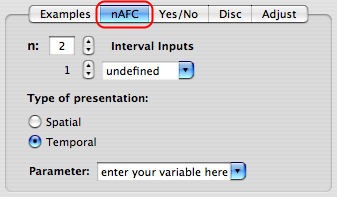
2) In the procedure-specific section of the panel, click on the nAFC tab to select the nAFC Procedure and view/edit its settings.

Make sure a 2AFC is specified by setting n to 2; n also corresponds to the number of inputs as there is one input for each stimulus interval in the nAFC Procedure.
Enter the subject response associated with each stimulus interval: select the first interval index with the stepper (1 in the above figure) and enter the keyboard key (m in the figure) followed by RETURN.

Similarly, set the z response key for the second interval.

Make sure the 2AFC is of the temporal type so the first interval (index 1) is selected when the subject presses the m key, and the second interval (index 2) is selected when the subject presses the z key.
Select the orientation variable from the pop-up menu (it appears in the menu because you entered it in Step 6 above). This is the stimulus parameter the subject will be judging so it is essential to make sure the method, procedure, and stimulus are connected via this parameter.
Remember that in an nAFC, the correct response corresponds to the interval with the highest value for the stimulus parameter: the subject should indicate right (m key) when the stimulus orientation is higher in the first interval than in the second interval (1>2), and vice-versa (left for 2>1, z key), so the correct response corresponds to the tilt direction of the stimulus (orientation increases in the anti-clockwise direction).
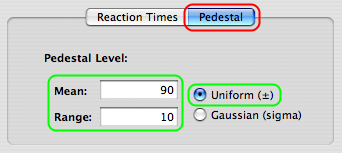
3) In the bottom-left, select the Pedestal tab. In each trial, the pedestal level is added to the value of the parameter indicated in the nAFC properties; therefore, the subject's judgment is relative to the pedestal level.
Set a uniform distribution of 90 ± 10 for the pedestal so the orientation threshold measurement is relative to the vertical. Random variation is required to prevent the use of the absolute vertical as a reference by the subject.
4) Click on the OK button to validate the changes and return to the Designer panel.
Step 8: Customizing the Visual Stimulus
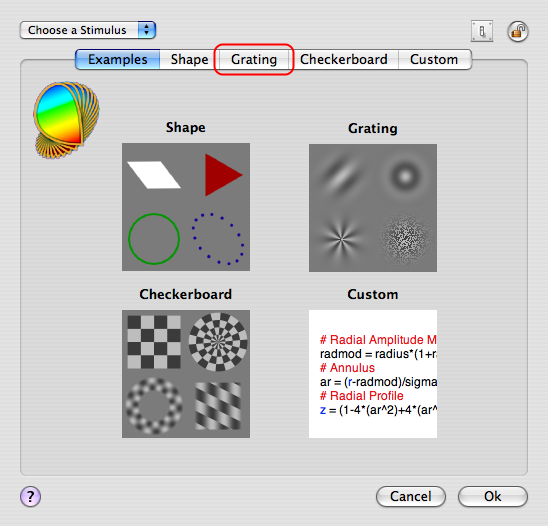
From the Designer panel, select the Gabor Visual Stimulus event, and click on the Inspector button to inspect its properties. On the properties page, click on the Grating tab to select the Grating-like Stimulus and view/edit its settings.
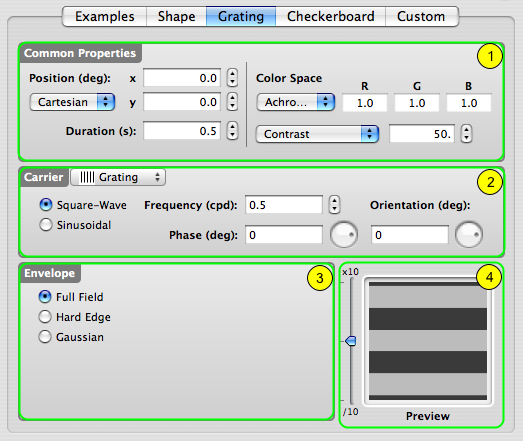
The properties page for the Visual Stimulus event consists of four sections:
1) A top section common to all types of visual stimulus that specifies their position, duration, and appearance
2) A middle section that specifies the carrier properties
3) A bottom-left section that specifies the envelope properties
4) A real-time preview in the bottom right-hand corner that can be zoomed in and out
Let's customize each of these sections:

1) Set the stimulus contrast to the maximum: 100%.

2) To create the Gabor stimulus: select the Grating type from the Carrier pop-up menu in the middle section; select Sinusoidal modulation; and set the values for the spatial frequency and phase.
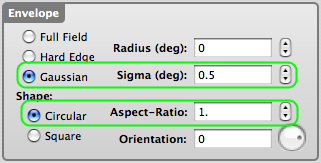
3) In the bottom-left section, select a Gaussian envelope and set the value for its sigma. Select the circular shape with an aspect-ratio of 1.
4) Note how the preview is automatically updated with your changes (use the slider to zoom the preview in and out).
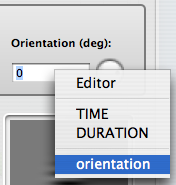
Finally and most importantly, connect the Carrier Orientation to the parameter used by the Method and Procedure by selecting the orientation variable that appears in the contextual menu when control-clicking on the text field, as illustrated above. Make sure to select the entire content of the text field before selecting the variable in the menu so the selection completely replaces the previous content.
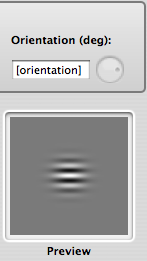
Note: Once selected, the variable name appears in brackets, thus indicating that the variable is providing a value to the stimulus parameter.
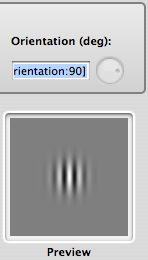
When using a variable-based expression to define a stimulus parameter, the preview is generated assuming a default value of 0 for each variable. To display a preview for a value other than the default, add the desired value preceded by a colon before the closing bracket (eg: [orientation:90]). This value is used only for preview purposes and has no effect on the experimental design.
We have finished with the experimental design so click on the OK button to validate the changes and return to the Designer panel.
Step 9: Checking & Running the Experiment
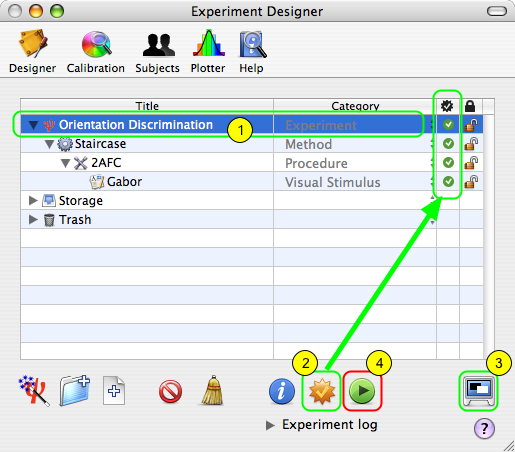
To run an experiment, simply do the following:
1) Select the Orientation Discrimination Experiment event which is at the root of your experiment design.
2) Check the validity of your design by clicking on the Check button in the button toolbar: if correct, all the indicators in the check column turn into green check marks.
3) Toggle the experimental session between windowed or full-screen mode: the windowed mode is appropriate for testing purposes only as neither Gamma correction nor timing checks are performed during the experiment.
4) Click on the Run button to run the experiment.
Tips:
Experiments can also be run through the Experiments menu which contains an up-to-date list of all the experiments present in the Designer panel.
If the Check button is disabled, Auto-Checking is activated so an event status is automatically updated every time the event is modified (see related option in the Preferences panel).
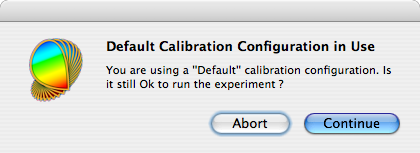
This warning message is displayed when no calibration configuration is specified for the experiment running (see the end of the Calibration Tutorial to learn how to specify a calibration configuration); however, you can still run the experiment using a default calibration by clicking on the Continue button.
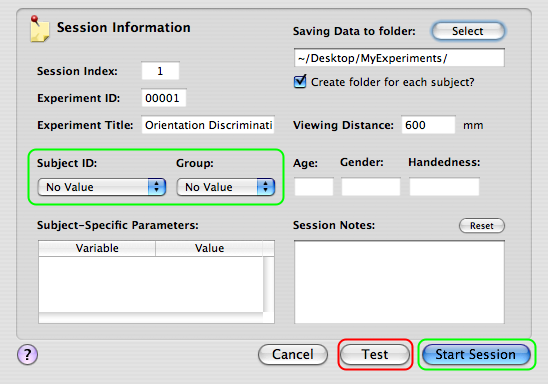
Before the session starts in full-screen mode, a panel summarizing the Session Information is displayed. You can either run the session in testing mode, which does not require the specification of the subject and group, or in real mode, if you specify them. In testing mode, no session data is actually saved in the results database.

If you have already entered subjects and groups in the Subjects panel (see the Subjects Tutorial), you can select them using the two pop-up menus provided. Their age, gender, and handedness are then shown.
Click on the Start Session button.
Press ESC (escape keyboard key) to stop the session at any time.
Step 10: Visualizing the Results
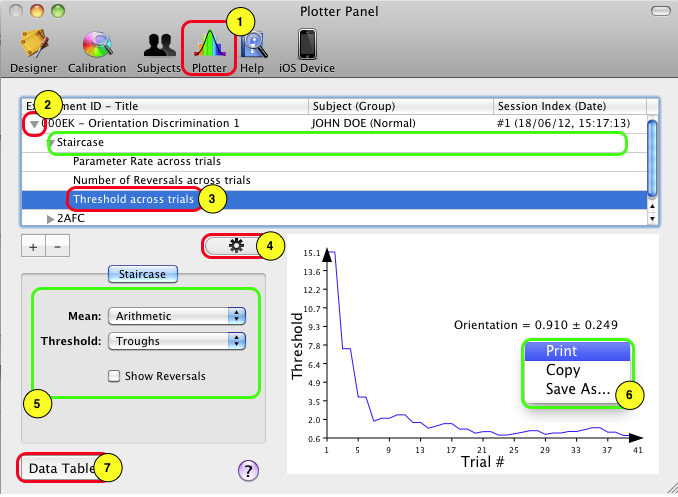
Upon termination of an experimental session, results data are created and saved in the Psykinematix database. The session data can also be visualized immediately on the Plotter panel:
1) Click on the Plotter icon in the toolbar to access the panel.
2) Option-click on the small arrow in front of the session entry to expand the whole hierarchy of the results data.
3) Select one of the entries in the final level of the hierarchy to plot its attached dataset (each entry contains a different dataset).
4) Click on the graph properties option to customize its appearance (through the graph properties palette),
5) Optionally customize the measurements (in the above example options are available for threshold estimation measured through a staircase method),
6) Control-click inside the graph to print, copy, or save it to a file.
7) Click on the Data Table button to reveal the spreadsheet containing the selected data (3) used to plot the graph (control-click inside the spreadsheet to print or export the data).
See the Subjects Tutorial and the Plotter Tutorial to learn how to select, import, and plot data collected during previous Psykinematix sessions.
Conclusion
In this lesson, you learned the Psykinematix basics: how to create the hierarchical structure of an experiment, how to customize the events, how to use variables to connect procedural and stimulus events, and how to run a session.
The next few lessons in this tutorial elaborate on this experimental paradigm by introducing various improvements over this single, static, stimulus version:
- Lesson 2 interleaves several staircases to investigate the effects of several experimental conditions, including spatial frequency and size.
- Lesson 3 implements a sandwich paradigm with forward and feedback masking noise.
- Lesson 4 adds a spatial and temporal context.
- Lesson 5 adds motion & dynamics through the use of a 1st-order drifting Gabor.